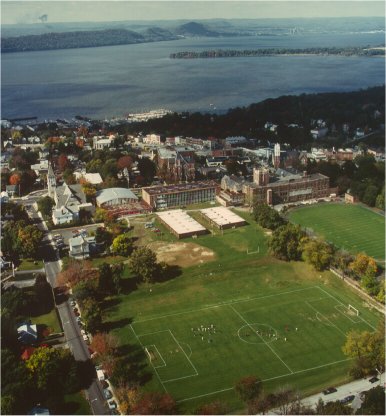June 21, 2005
HITTING THE BRICKS

The village of Haverstraw was known for its brick-making, according to a 2003 article in theJournal News:
At the height of its prosperity, Haverstraw village was part of a bustling region regarded worldwide as a premier brickmaking area.Ten thousand people in the area depended upon the bay-area industry for their livelihood. Outsiders flocked to the village, which was a thriving metropolis for more than 100 years.
Though Haverstraw dates back to 1712, it gained prominence when its brickyards began operating in the late 1700s.
Brickmakers were confounded by the problems they encountered in the oftentimes irregular shape of the building blocks, which at that time were made almost entirely by hand. A few rudimentary tools had been introduced to help streamline production, but it wasn't until 1852, when Richard VerValen developed his brickmaking machine, that the industry exploded.
VerValen, who knew the industry and had "an inventive mind," pondered the dilemma for a time, according to the late historian, author and area resident, Daniel deNoyelles, in his book, "Within These Gates."
A Closter, N.J., native, VerValen had lived in Rockland as a child, then left for upstate New York before returning to Haverstraw in 1848, where he worked manufacturing stoves and plows in his foundry, the book said.
According to legend, deNoyelles wrote, it was in the middle of a Sunday church sermon that VerValen had a breakthrough.
VerValen patented his machine in 1852 and, deNoyelles said, its principles were "so workable and so novel to brickmaking" that they were used until a more advanced machine, incorporating some of his original ideas, was developed in the 1920s.
So successful was his machine that patent holders of other models sued VerValen, who was awarded the right to call himself the machine's originator after carefully explaining his principles. The cases against him were dropped, deNoyelles wrote.
"That machine allowed them to increase the production, oh, I don't know, 10-fold, 20-fold," said Tom Sullivan, a local history buff.
Demand had been on the upswing since a terrible fire in 1835 in New York City's financial district destroyed 13 acres of buildings.The tremendous need for materials to rebuild and to accommodate the city's growing immigrant population gave impetus to the growth of the north Rockland brickmaking industry.
The VerValen machine revolutionized the way bricks were made. Rather than have workers pour the clay into molds by hand, the machine automated the molding process, allowing a stiffer clay mixture to be used. The result was a more uniformly shaped brick.
VerValen's invention so improved the brickmaking process that he quickly got 150 orders from operators in the area.
Wassmer said the machine changed the face of the industry, and of the area. It set Haverstraw on a path of prosperity that would last for 75 years.
Posted by Jeff at June 21, 2005 07:08 AM | TrackBack